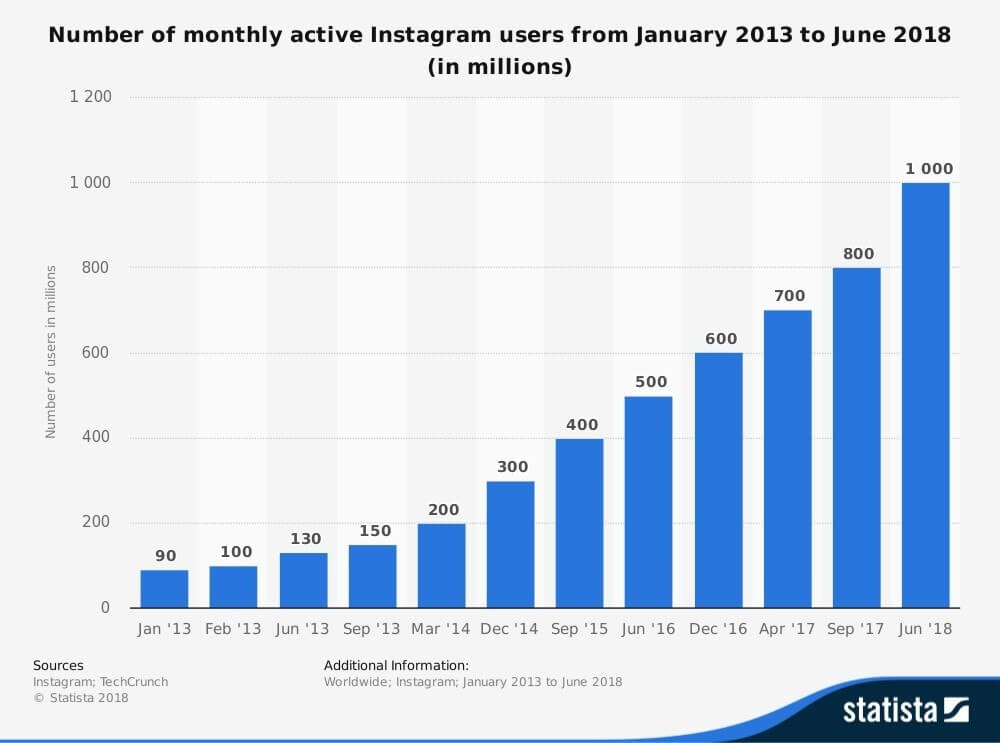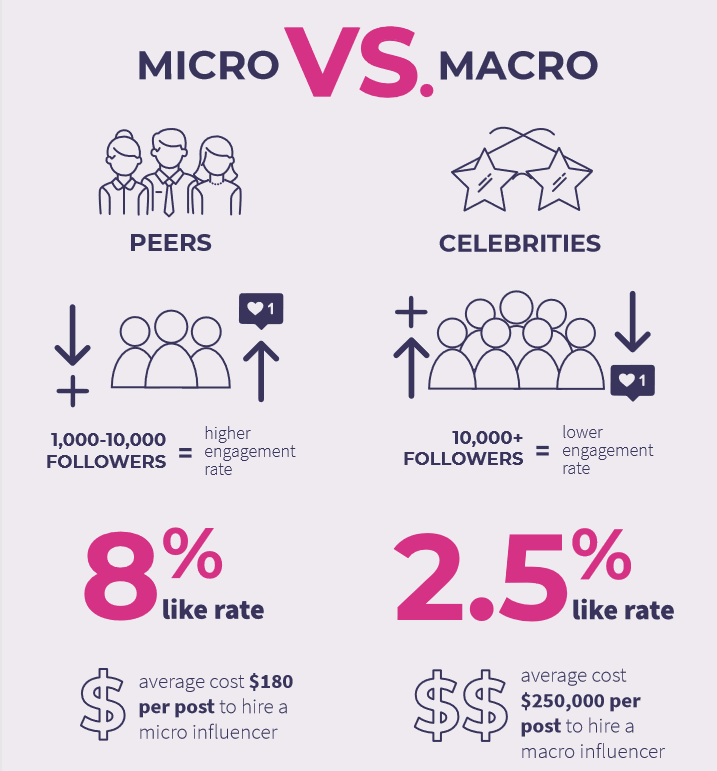Influencer Marketing Trends To Watch For In 2019
The new year is fast approaching and brand marketers are in full pursuit with planning their 2019 influencer marketing strategies. These strategies will still use many of the techniques that were popular in 2018. But, if brands want to swell with success in their marketing strategy next year they should be aware of the key trends we have listed below.
Trend #1. Instagram Will Remain a Core Influencer Marketing Channel in 2019
Instagram is putting a lot of effort towards influencer marketing and will continue to increase in 2019. In 2018, Instagram reached one billion monthly users and is now one of the leading platforms for influencer collaborations for brands. In fact, a hash off study found that influencers have expressed their intentions to continue prioritizing Instagram into 2019. One of the main reasons why Instagram has high-performance potential lies within the extremely engaged community filled with rich visual content and brands that can utilize this content to amplify their voice online.

Trend #2: Brands Will Become More Strategic in Developing Long-Term Influencer Partnerships
For an industry expected to take over in 2019, not much stands in the way of influencers steering the ship. As long as the marketers investing in the strategy continue to treat it as a relationship, rather than just a business deal.
Just like any relationship, it’s probably a good idea for all parties involved to have a large interest in maintaining the partnership. Uneven relationships cause misalignment when it comes to measuring the ROI. Just as influencers invest in building long-term relationships with their followers, brands need to have that same drive when it comes to investing in long-term influencer relationships.
Here are the benefits for both parties in a long-term influencer relationship:
• Long-term relationships are popular with brands looking to combat fraud.
• Repeatedly exposes your brand to the influencers followers.
• Gives brands constant access to influencer creativity over time.
• Having a long-term partnership with an influencer improves the digital conversation about your brand and also increases word-of-mouth referrals.
• When an influencer gears up for a multicampaign or project dealing with a brand, they are more likely to invest in understanding the brand and category and forming a personal relationship with your products.
• The influencer is more involved in the brand and can provide valuable insights from a consumer perspective.
Trend #3: Influencer Generated Content (IGC) Will Be Key Asset Across all Marketing Channels
IGC makes it possible to engage your audience in a deeper, more meaningful way, and that’s a connection that you should take advantage of in 2019. Educated brands are using influencer content across all their marketing channels by mixing this content across email, product-display pages, and advertising campaigns. This tactic helps maintain an authentic and consistent brand appearance across all channels, so the audience is receiving a familiar but tailored experience for the channel they’re using.
Trend #4 Video + Live Video
Every year, video content continues to grow, and in 2019, it’s expected to once again dominate the market. This is especially true for live videos. Having always been popular on YouTube, the trend has now taken over Facebook and Instagram, to the point we get a notification when someone is going live.
According to Social Report, “65% of ad impressions on Instagram were the result of video content and live video marketing is expected to make up an astounding 80% of all internet traffic.” But how can you make video work for you and your brand’s influencer marketing campaigns? It has everything to do with trust.
Trust is important because with all the competition between brands, trust can make a huge difference in who consumers turn to. When an audience is exposed to both professional and user-generated content, viewers retain 95% of a message when they watch it in a video compared to 10% when reading it in a text. Not only does a video grab immediate attention, but it also causes viewers to like, comment and share the content after feeling a certain emotion. With a human touch, you can quickly gain consumers’ trust, evoke curiosity, give them confidence, and even entertain them.
Trend #5 Micro-Influencers Are Gaining Popularity in 2019
As opposed to major influencers, micro-influencers exist on every social platform. They have followings of fewer than 10,000 people, but most of their followers are genuinely interested in what they have to say. And they’re very engaged – micro-influencers are often considered experts in their niche.
The smaller pages are not always targeted by advertisers, so they are trustworthy and down-to-earth. Their marketing potential is very high and marketers are about to recognize this in 2019. Large influencers still create amazing, engaging, authentic content that their readers and followers absolutely love. But, we feel that 2019 will be the year for micro-influencers.
Why work with micro-influencers instead of large, celebrity influencers?
• They’re easier to approach and work with.
• Their content usually ends up having more engagement
• Their opinions are a trustworthy source of word-of-mouth promotions.
• They are relatable because they are just like everyday consumers.

Trend #6 More Detailed Tracking and Reporting
One of the essential things in influencer marketing next year will be, brands requiring more detailed reporting and analytics from their influencer marketing campaigns. In the past, brands have struggled to justify large budgets on influencer marketing when they couldn’t access the data to justify it. Additionally, a lack of detailed tracking leaves the advertiser blind regarding where the best place to spend money in the future is.
However, modern influencer marketing should require real-time analysis of not just engagements but clicks and sign-ups from each piece of content across all social media platforms and blogs so the brand can make better marketing decisions.
Trend #7 Taking Fraud More Serious
Influencer fraud occurs when fake “influencers” decide to buy followers or use bots to generate comments. These fake and fraudulent influencers can be a serious issue for brands and unfortunately, there are some fraudulent people who want to take shortcuts to build the kind of authentic account that takes years to achieve.
Luckily, we have a procedure that helps us identify scammers! We have worked with our trusted influencers for many years on multiple campaigns. However, when vetting new influencers, we have a strict procedure we follow:
• Manually audit comments and likes:
Our system auto detects fraud, however, our campaign managers vet through all our influencers for real followers and engagement, along with comments and likes. If comments are irrelevant to the post, it’s a result of purchased interactions. We check the profiles that “interacted with our influencers content or that left irrelevant responses and label the accounts as fraudulent as we further investigate.
• Auditing influencers for engagement or followers:
We look for organic results from prior posts for consistency. If one post for example on YouTube has dramatically more views than their average, it’s likely due to a surge in bot engagement. There are exceptions for paid amplification to increase performance.
• Verify audience demographics:
When sourcing influencers, we have them verify their audience by giving us access to their API’s, Google analytics and screenshots of their social platforms insights dashboard.
• Combing through content:
We look to see if they work with other brands and check the frequency of each post. If the influencer is selling a new product with every other post, this is usually an indicator that the influencer isn’t loyal to any one brand. The “One and done” approach doesn’t do a thing for a brand looking to build equity with an influencer’s following. Consumers are more apt to purchase or identify with products they see their idols use on an ongoing basis.
• Best Practices:
We review influencer’s recent brand integrations and see if they know how to effectively integrate a call to action in their messaging. Every piece of content should include a call to action to drive authentic engagement.
Taking the right steps in spotting fake influencers, will give brands a better chance in their influencer marketing efforts this coming year, instead of wasting their budget on collaborating with fraudulent accounts.
Trend #8 Instagram Stories
A lot of changes have been made since Instagram stories came into existence. Now you can tag accounts, create ads, add hashtag stickers and also links (swipe up feature). When viewers see something they can click on, they are more likely to give it a try. Most brands take extra time to perfect every photo they post, but now Instagram stories can provide a completely different style of content, the behind the scenes effect.
Viewers want to see content they wouldn’t typically see – this especially applies to brands that are big and always publish well-defined and intricate content. The behind the scenes effect will make followers feel attached to whatever real-time event going on that day while allowing them to feel like they are experiencing something exclusive.
Trend #9 Programmatic Paid Media As A Way To Deliver And Measure ROI – Artificial Intelligence
Artificial intelligence is a growing part of all digital marketing, and influencers are no exception. AI offers multiple solutions to brands looking to research and hire the best influencers. According to Single Grain, “True AI platforms, move beyond image processing and analyze years of influencer content to determine the topics, and brands that influencers are talking about. Audience sentiment, aesthetic style and, most importantly, how effective their content is driving traffic, engagement and product sales.”
However, there is no fear that AI will replace the human-centric nature of influencer marketing. The same article states that while AI will help brands make informed decisions, they still rely on the element of human creativity and strategy. The drop in organic reach due to changes in social media algorithms along with difficulty in scaling influencer campaigns has brought on some challenges in influencer marketing. But the reality is that social media algorithms determine which followers will see the content. There is no way to guarantee that the “premium” audience of the influencers will see the content.
How do you ensure that you amplify your content to reach a new and highly valuable audience? How do you effectively boost influencer content without forcing them to sacrifice control of their handle? And finally, how do you effectively measure the ROI of your efforts, including conversion all at once?
The best possible solution is to use influencer content amplification that focuses on bringing programmatic media buying behind your influencer marketing program. It enables you to run optimized amplification through influencer accounts and ensures that you reach a highly engaged audience. Influencers can securely share audience data and permissions with their brand partner and brands can leverage the platform to deliver influencer content as paid ads that are optimized across audiences.
Trend #10 Influencer Agencies Will Become More Popular
Influencer marketing also consists of a combination of agencies (teams of marketers) and web-based software. These agencies have a wealth of experience when it comes to vetting and selecting influencers, and will also use data to see which influencers best fit with a specific brand. When influencer agency’s get a seat at the client’s table, the results lead to more effective and memorable campaigns.
Many brands that have relied solely on internal staff are beginning to acquire outside agencies to help with a variety of services, which include:
- Identifying niche influencers
- Negotiating the budgets with influencer
- Offering a strategy for a brand’s campaign that will maximize engagement and audience reach
- Approving content before it goes live
- Managing the entirety of the campaign and making sure everything is performing correctly and meeting client expectations
- Providing post-campaign analytics
Trend #11 Engagement Rates Are Still Important
The size of your audience on social media doesn’t matter if no one is paying attention. We’ll go so far as to say that how many followers you have doesn’t matter at all. So it’s time to stop paying attention to your follower counts on social media and instead, spend your time focusing on what matters – social media engagement.
Depending on your goals, there are a ton of different kinds of engagement you can monitor across social media: clicks, likes, shares, comments, replies, etc. The specific type of engagement you’re measuring will vary over time. Most people will like a page because they see friends doing so, but over time, will forget all about that popular page, so a high number of likes on a page doesn’t necessarily mean the brand is doing well. On the other hand, when a large number of people are talking about the brand, even if the likes are relatively low, it means the brand is getting more exposure, liking its content, sharing its content and generally recommending the page to others, is a result of a high engagement rate.
Wrapping It All Up
There you have it, social media is not going anywhere, and the use of influencers in marketing is only going to continue on the upward trend in 2019. I hope you see that having a successful marketing campaign needs to come from a real thirst for pleasing your customers, not from pushing money into products that aren’t well received by the market.

